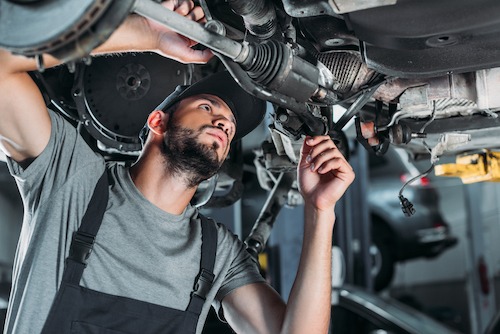All Categories
Featured

Car diagnostics are essential for preserving vehicle health and ensuring secure driving, and with rapid technical innovations, the method we diagnose vehicle concerns has actually significantly enhanced. Today's auto diagnostics rely on cutting-edge technologies to quickly recognize issues, simplify repairs, and decrease downtime for both vehicle drivers and cars. Allow's discover a few of the latest modern technologies changing the auto diagnostics market.
- OBD-II and Improved Scanners. The OBD-II (On-Board Diagnostics) system has actually been a staple in modern lorries for years, allowing mechanics to review mistake codes that can pinpoint problems. Current developments have actually transformed OBD-II scanners right into much even more effective devices. These enhanced devices now supply extensive car details, allowing a much more accurate medical diagnosis of intricate issues.
Key Includes:
Advanced Code Evaluation: New OBD-II scanners can review a broader selection of mistake codes, consisting of those pertaining to advanced systems like crossbreed powertrains or electrical automobile (EV) components. Wireless Connection: Some OBD-II scanners currently link through Bluetooth or Wi-Fi to a smartphone or tablet computer, providing real-time analysis information and efficiency monitoring without physical cords. 2. Expert System (AI) and Artificial Intelligence. Synthetic Intelligence (AI) and artificial intelligence are ending up being game-changers in vehicle diagnostics. These technologies assess vast amounts of data collected from vehicles and use anticipating versions to spot concerns before they trigger recognizable symptoms. By identifying patterns from countless vehicle documents, AI can assist professionals diagnose problems with a precision level that had not been possible before.
Benefits:
Predictive Upkeep: AI can predict when parts could stop working based on information trends, allowing repairs to be made before break downs take place. Faster Diagnoses: AI systems can quickly sort with diagnostic data and advise possible repairs, quickening repair times. 3. Telematics and Remote Diagnostics. Telematics systems make it possible for lorries to communicate directly with service facilities or third-party platforms by sending performance data in real-time. This allows auto service center to detect concerns from another location and advise upkeep before the cars and truck owner even notices the problem.
Benefits:
Real-Time Monitoring: Professionals can check an automobile's systems continually, allowing them to capture possible concerns as they arise. Over-the-Air (OTA) Diagnostics: Some vehicles can send diagnostics wirelessly to makers, enabling repair services or software updates to be performed remotely, reducing the need for solution visits. 4. Thermal Imaging Cameras. Thermal imaging is an ingenious way to discover possible issues that are otherwise unnoticeable to the naked eye. Utilizing infrared innovation, thermal electronic cameras highlight temperature variations in components, assisting service technicians spot issues like overheating wiring, liquid leaks, or engine obstruct splits.
Benefits:
Non-invasive Detection: Thermal video cameras allow professionals to evaluate hard-to-reach locations without dismantling parts of the vehicle. Quick Problem Recognition: Locations that suggest concerns, such as overheating components or short circuits, can be identified virtually promptly, making repair services more reliable. 5. Borescopes and endoscopes. Endoscopes and borescopes are small, flexible cams that allow technicians to inspect hard-to-reach places in lorries, such as within engines, exhaust systems, or beneath the auto's body. These devices are important when detecting problems in restricted or hidden rooms.
Secret Conveniences:
Access to Hidden Areas: Specialists can take a look at components of the lorry that would usually call for disassembly, making the analysis procedure much faster and less invasive. High-Resolution Imaging: These gadgets typically come with high-def electronic cameras, permitting for in-depth visual assessments. 6. Increased Fact (AR) Enhanced fact (AR) is starting to find its place on the planet of car diagnostics, enabling professionals to superimpose car information over the real-world photo of the vehicle. AR systems can provide service technicians with instant info and instructions while they are dealing with the car.
Applications:
Aesthetic Help: AR glasses or tablet computers present digital overlays that reveal schematics, diagnostics, or step-by-step fixing guides while specialists function. Efficiency: With AR, professionals can make fixings faster because the info they require is directly in front of them in the kind of interactive layouts and data. 7. 3D Imaging and Scanning. 3D imaging technology is significantly being used in the auto repair sector to provide thorough, three-dimensional sights of vehicle elements. This innovation can assist service technicians recognize misalignments, damages, or wear and tear that may not be visible in conventional 2D evaluations.
Advantages:
Detailed Examinations: With 3D scans, technicians can acquire a detailed understanding of an automobile's parts, especially in intricate mechanical or architectural systems. Precision: The high-resolution nature of 3D imaging enables very precise measurements, making sure that repair work are precise and effective. 8. Lorry Diagnostics by means of Cloud Computer. Cloud-based diagnostic tools are changing how auto data is analyzed and saved. Cloud technology enables professionals to accessibility automobile diagnostics data from anywhere, enabling quicker decision-making and enhancing collaboration in between solution facilities and suppliers.
Key Includes:
Real-Time Updates: Cloud-based systems supply continuous updates on lorry efficiency, permitting solution professionals to monitor a vehicle's health from another location. Centralized Information: Information from several automobiles can be streamlined on cloud systems, making it simpler to recognize patterns and provide tailored options. Final thought. The latest analysis modern technologies are changing the way auto repair services and maintenance are done. From AI-powered predictive upkeep to real-time telematics, these advancements ensure that issues are recognized faster and with higher accuracy. Whether it's through advanced OBD-II systems, remote diagnostics, or advanced devices like thermal imaging and boosted truth, the future of auto diagnostics is becoming progressively high-tech, making vehicle repair service extra reliable, accurate, and less invasive for both specialists and automobile owners alike.
Latest Posts
Why Choose Timber Secure Fencing from Washington Fencing Business?
Published Apr 20, 25
1 min read
Practical Carpet Take Care Of Lasting Elegance
Published Apr 20, 25
2 min read
Achieve Your Monetary Desires with WyHy's Wealth Management Solutions
Published Apr 20, 25
1 min read